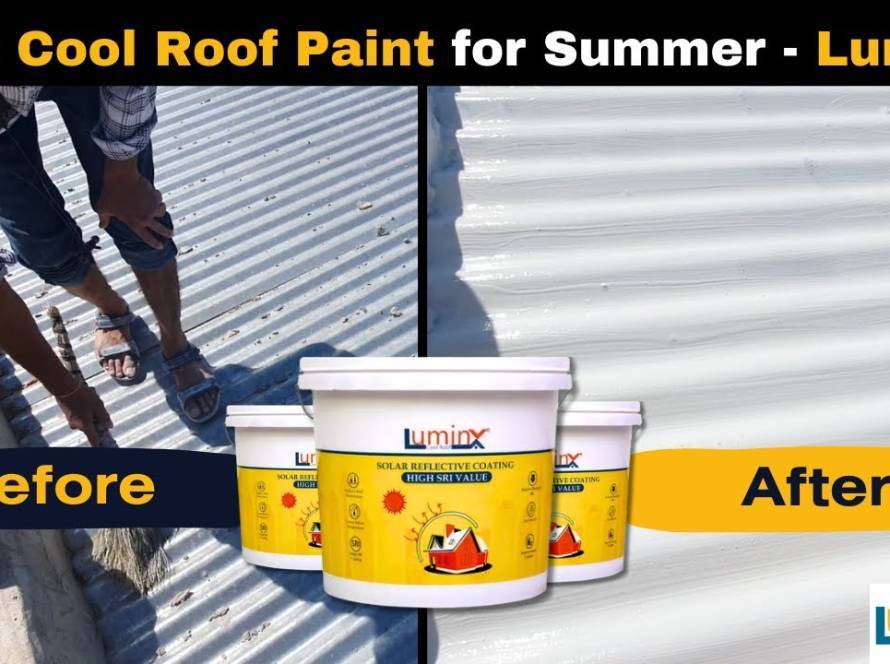Consider your house as a solar shield that keeps you safe from the intense heat. Imagine now a roof covering as the armour that fortifies this barrier and blocks the sun’s unrelenting rays. Cool roofs have become a practical answer for house and business owners in an era where environmental conservation and energy efficiency are becoming increasingly crucial. Concerning the primary variables affecting relaxed Solar reflective roof coating, possible trade-offs, and the consequences of choosing to install them, this article seeks to offer an unbiased and educational analysis of the subject. Because terrace cooling paint has many benefits, it is a standard option for residential and commercial structures. This article will discuss the benefits and installation tips in depth.
- Energy Savings
Solar reflective roof coatings reflect more sunlight and absorb less heat than conventional roofs. This Heat-Resistant High Temperature Paint quality helps maintain lower interior temperatures by absorbing less solar heat. Cool-roofed buildings also need less energy to cool during hot weather, which results in decreased energy usage and electricity bills.
- Upgraded Comfort
In the summer, Solar reflective roof coating helps to keep interior temperatures bearable mainly by reflecting sunlight and lowering heat absorption. Because air conditioning is less needed to keep things cool, this can make living or working conditions more comfortable for occupants. Because cool roofs lower ambient temperatures, they can also lessen the urban heat island effect in crowded regions.
- Extra Long Roof Lifespan
Furthermore, the reflecting qualities of cool roofs extend the roof’s life. Solar reflective roof coating experiences less thermal expansion and contraction, which can, over time, lead to the degradation of roofing materials by absorbing less heat. Fewer maintenance and replacements may result in long-term savings for building owners.
- Gains for the Environment
Cool roofs are better for the earth because they use less energy, and cool air produces fewer greenhouse gases. Less fossil fuels are needed to make electricity because cool roofs use less energy, lowering air pollution and climate change. In addition, cool roofs can help lessen the damage that the urban heat island effect does to the environment and people’s health.
- Savings
The long-term benefits from lower energy bills and maintenance expenses cover the original cost of constructing a cool roof, which may be more expensive initially than a standard roof. Building owners often can afford a cool roof since the energy savings it produces can pay for itself in a few years.
- Regulatory Compliant
Numerous municipal governments and building codes are enacting laws and incentives to encourage using cool roofs as worries about energy efficiency and environmental sustainability continue to mount. A cool roof can assist building owners in meeting these requirements and also make them eligible for tax credits or financial incentives provided for energy-efficient improvements.
The Installation of a Cool Roof
Cool roofs are a more common energy- and heat-saving building solution. They reflect more sunlight than ordinary roofs, significantly lowering the cooling energy needed. What should you expect from the installation process if you consider giving your building a cool roof? It must be installed in several stages to ensure a cool roof reduces heat absorption and increases energy efficiency. The procedure is broken out here:
- Roof Inspection
Before installing a cool roof, the current roof structure must be carefully examined. This includes evaluating the roof’s state, pointing out any damage or degeneration, and deciding whether or not excellent roof installation is appropriate. Should repairs or adjustments be required, they ought to be finished before the installation.
- Selecting Materials
After the roof examination, choose cool roof materials. Material choice depends on aesthetics, climate, and budget. It is crucial to select premium, energy-efficient materials that comply with local building regulations and requirements.
- Surface Preparation
To guarantee adherence and longevity, the roof surface has to be well prepared before the cool roofing materials are applied. This could involve clearing the roof’s surface of debris, dirt, and any current coatings. Sometimes, fixing flaws or damage in the roofing substrate will be necessary. The longevity and best functioning of the cool roof system depend on surface pretreatment.
- Utilizing Reflective Coatings
Asphalt or bitumen-based roofs are often installed with reflective coatings for cool roofs. Heat Resistant High Temperature Paints coatings lower indoor temperatures and energy bills by reflecting sunlight and reducing heat absorption. Spray or roller coatings may require many layers for maximum results. Follow manufacturer instructions for proper application and coating curing.
- Installing Cool Roof Membranes
Excellent roofing materials last long and save energy on flat or low-slope roofs. These coverings are available in PVC, EPDM, or TPO. Large membrane sheets are welded or attached to the roof substrate. Correct installation methods depend on long-lasting performance and watertight sealing. Cool roofs are becoming increasingly popular to save energy and heat for buildings. Heat Resistant High Temperature Paints reflect more sunlight than regular roofs, which can cut the energy needed to cool considerably. If you want to put a cool roof on your building, here’s what you can expect during the installation.
- Included Roofing Accessories
Any roofing accessories or penetrations—such as vents, skylights, and HVAC equipment—must be addressed during excellent roof installation. These spaces must be adequately insulated and shut as possible by heat gain sources to stop energy loss. Around penetrations, flashing and sealants can be used to provide a watertight seal; insulating materials can lower thermal bridging and increase energy efficiency.
- Warranty and Upkeep
Quality assurance inspections must be conducted after the cool roof installation is finished to ensure that the job complies with industry norms and requirements. Roofing experts or building inspectors may be called upon to verify that the installation was carried out accurately and on schedule. The long-term effectiveness and durability of the Terrace cooling paint also depend on routine maintenance and inspection. This can involve routine seal inspection and cleaning.
Conclusion
Many factors make the Best Heat-Resistant Paint for Terrace cooling paint is necessary. Above all, it helps a building absorb less heat, which lowers energy costs and improves interior temperature. Moreover, the urban heat island effect—which results from cities and other metropolitan areas absorbing and radiating heat, rising temperatures, and energy consumption—can be lessened with heat-resistant high-temperature paint. They can have their heat-reflective qualities, durability, and application ease compared.




